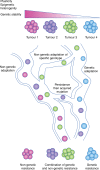Principles and mechanisms of non-genetic resistance in cancer
- PMID: 31831859
- PMCID: PMC7028722
- DOI: 10.1038/s41416-019-0648-6
Principles and mechanisms of non-genetic resistance in cancer
Abstract
As well as undergoing genetic evolution, cancer cells can alter their epigenetic state to adapt and resist treatment. This non-genetic evolution is emerging as a major component of cancer resistance. Only now are we beginning to acquire the necessary data and tools to establish some of the underlying principles and mechanisms that define when, why and how non-genetic resistance occurs. Preliminary studies suggest that it can exist in a number of forms, including drug persistence, unstable non-genetic resistance and, most intriguingly, stable non-genetic resistance. Exactly how they each arise remains unclear; however, epigenetic heterogeneity and plasticity appear to be important variables. In this review, we provide an overview of these different forms of non-genetic resistance, before exploring how epigenetic heterogeneity and plasticity influence their emergence. We highlight the distinction between non-genetic Darwinian selection and Lamarckian induction and discuss how each is capable of generating resistance. Finally, we discuss the potential interaction between genetic and non-genetic adaptation and propose the idea of 'the path of most resistance', which outlines the variables that dictate whether cancers adapt through genetic and/or epigenetic means. Through these discussions, we hope to provide a conceptual framework that focuses future studies, whose insights might help prevent or overcome non-genetic resistance.
Conflict of interest statement
The authors declare no competing interests.
Figures


References
-
- Nowell P. The clonal evolution of tumor cell populations. Science. 1976;194:23–28. - PubMed
-
- Martincorena I, Campbell PJ. Somatic mutation in cancer and normal cells. Science. 2015;349:1483–1489. - PubMed
-
- Holohan C, Van Schaeybroeck S, Longley DB, Johnston PG. Cancer drug resistance: an evolving paradigm. Nat. Rev. Cancer. 2013;13:714–726. - PubMed
-
- Cavalli G, Heard E. Advances in epigenetics link genetics to the environment and disease. Nature. 2019;571:489–499. - PubMed
-
- Huang S. Tumor progression: chance and necessity in Darwinian and Lamarckian somatic (mutationless) evolution. Prog. Biophys. Mol. Biol. 2012;110:69–86. - PubMed
Publication types
MeSH terms
Grants and funding
LinkOut - more resources
Full Text Sources
Medical
Research Materials

